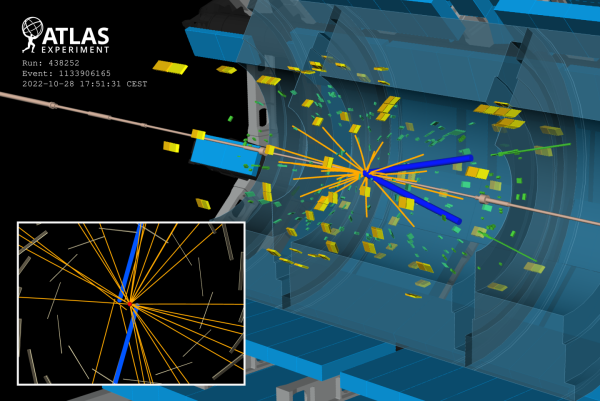ESnet Meets with High Energy Physics Scientists to Plan Future Networking Needs
Science Engagement Team (engage@es.net)

Display of a collision event recorded by the ATLAS detector during a search for new physics phenomena conducted with data from Run 3 of CERN’s Large Hadron Collider. More than 6,000 scientists in 46 countries work on the ATLAS experiment; ESnet connects CERN to the LHC computing and data analysis sites in the United States, supporting U.S. contributions to ATLAS. (Image: ATLAS/CERN; read story)
ESnet provides fast and reliable data networking for DOE scientists, but how do we know what they need? We ask them!
In late September, ESnet’s Science Engagement Team, Executive Director Inder Monga, and staff from across the organization met with a group of scientists who are supported by the U.S. Department of Energy (DOE) Office of Science High Energy Physics Program (HEP) to learn about their science plans for the next several years. We spoke with HEP program scientists collecting data from 408 kilometers above ground on the International Space Station (Alpha Magnetic Spectrometer) to 2 km below ground in a mine (SNOLAB), from a mountain in Arizona (Dark Energy Spectroscopic Instrument) to one in Chile (Rubin Observatory Legacy Survey of Space and Time), and from neutrino experiments at Fermilab that penetrate the Earth’s crust to the high-energy particle collisions of the ATLAS and CMS experiments at CERN’s Large Hadron Collider, which are helping us better understand the universe.

ESnet Planning & Architecture Group Lead (Acting) Chris Tracy reviews a case study
Scientists from more than a dozen major DOE high energy physics collaborations shared their plans for collecting data and connecting with teams of thousands of collaborators to analyze that information. Many need to transfer large volumes of data, often in real time, to DOE data storage and computing facilities around the world. Some studies have already been collecting data for decades, while others won’t start formal data collection for another couple years.
The meeting was part of the ongoing ESnet networking Requirements Review process conducted with each of the six DOE Office of Science programs every few years. The outcomes from each review are published in a comprehensive report with multiple case studies, so that the information is available to other DOE SC programs, user facilities, collaborators, and stakeholders to inform planning for cutting-edge science to meet the DOE mission.
"These discussions with scientific and program leadership not only inform our planning for capacity and services, they also highlight opportunities for collaboration and co-design," said Monga. "For example, the LHC experiments’ researchers are a key constituency for our trans-Atlantic networking strategy, and our co-design efforts to integrate our SENSE platform with the Rucio scientific data management system will improve our ability to support particle physics, astronomy, and other HEP users."
“While it was a lot of work to prepare, the ESnet Requirements Review was very beneficial for ATLAS,” said Shawn McKee, Research Scientist at the University of Michigan Physics Department and US ATLAS Networking Project Manager. “It gave us the opportunity not only to think carefully about our current and future science needs, but also allowed us to interact with a broad range of ESnet staff to develop and extend our collaboration. The discussions and planning around something as foundational as the network are critical for us to prepare for a successful future in high-energy physics.”
The Nuclear Physics Requirements Review report was published in July 2024. The HEP Requirements Review report will be available in spring 2025. To view past reports and learn more about the ESnet Requirements Review program, visit ESnet’s web page for the networking requirements review program.

Representatives from ESnet, the Department of Energy, NERSC, SLAC National Accelerator Laboratory, University of Michigan, and Argonne, Lawrence Berkeley, Fermilab, and Oak Ridge National Laboratories gathered in Rockville, Maryland, to collaborate on ESnet’s High Energy Physics Requirements Review process.

